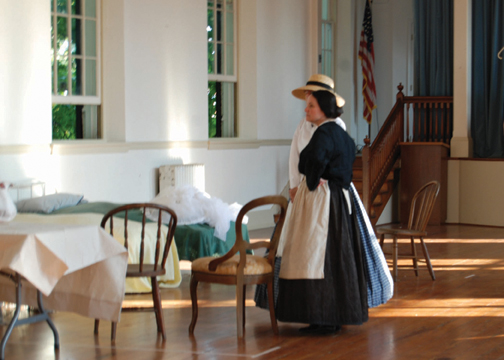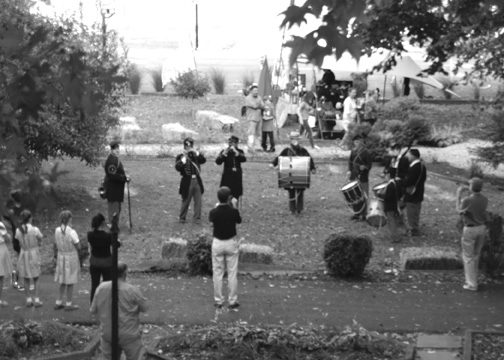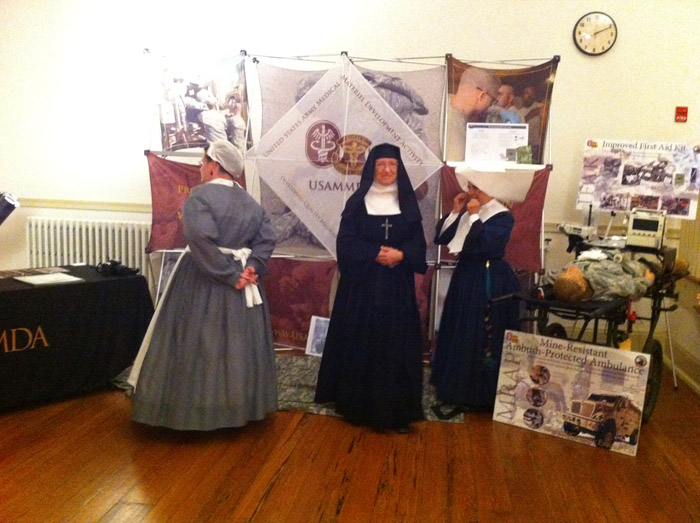One Vast Hospital commemorative weekend: A modern military medicine comparison



Downtown Frederick, Md., looked very different 150 years ago, but it is not the buildings and streets that have changed, it is what was inside the buildings. Several churches and historic buildings downtown were transformed into hospitals, housing the wounded soldiers fighting in local battles during the Civil War. One of the buildings that became a hospital was and is today a Catholic school for girls, the Visitation Academy. During the Civil War, Union Soldiers were brought to Visitation Academy, and the Sisters of Charity came to be nurses to the wounded; all the while, sixty female boarding students sat in their classes at the Academy and lived life as usual. The One Vast Hospital event transformed the Academy back a century and a half, recreating Frederick life during a time of civil war.
The One Vast Hospital commemorative weekend event was a walking tour for visitors to view the original locations of the field hospitals during the Civil War, in the downtown Frederick area. Located on East 2nd Street, Visitation Academy was recreated as hospital number five, just as it was 150 years ago. Hospital beds were placed in the auditorium and re-enactors dressed as the Sisters of Charity, and worked by the hospital beds as they may have been seen all those years ago.
Lt. Col. Karen Kopydlowski, deputy commander of U.S. Army Medical Materiel Development Activity, attended the event with her family during the VIP tour.
"We felt like we stepped back in time when we entered the gates of the Academy, heard the fife and drum corps, and saw all the re-enactors set up in the courtyard and in the facility," said Kopydlowski.
Along with the displays of the past artifacts, re-enactors and storytellers, was a present-day display of how Army Medicine has transformed. USAMMDA was invited to be part of the event to show the contrast of present day Army Medicine. USAMMDA highlighted the improved first aid kit, and displayed the advanced equipment used by medics today, compared to that used during the Civil War. Today every single Soldier is issued an Improved First Aid Kit, or IFAK, and is trained on how to use all of the equipment provided.
"USAMMDA's display was compelling from the standpoint that it showcased the advances in lifesaving medical technologies far forward on the battlefield and during evacuation to greatly improve survivability from combat wounds," said Kopydlowski. "In contrast, the first hope for any medical care for a Civil War Soldier was only after he was evacuated to a general hospital where he could be seen by a physician."
The combat application tourniquet, which was created based on the need to stop severe blood loss, was also on display as part of the IFAK. During the Civil War, not every Soldier had a tourniquet, and the make-shift ones that were created did not perform the job required. Many men lost limbs in the Civil War because of inadequate tools and physicians. Today, every deployed Soldier carries at least one tourniquet and is trained on how to use it.
The display at Visitation Academy was purposefully done to tell the story through the past, up to modern day. According to Kopydlowski, the flow and layout of the displays was a clever way to walk the visitors through the medical care process, showing the medical care that a Civil War Soldier experienced, and then comparing it with the present day process and new technologies for medical care.
"When seen [the USAMMDA display] next to the University of Maryland Shock Trauma display, it was clear how military trauma care has improved civilian care and that there is a continuous exchange of best-practices and innovations between the two," said Scott Fullerton, event volunteer with The National Museum of Civil War Medicine. "Many people commented that they were unaware of Maryland's role in these innovations and that the Command responsible for this is here at Fort Detrick, a center of important innovation and something to be proud of."
An estimated one thousand visitors attended the event over the weekend. Fullerton stated that the two most common comments heard from visitors, were a variation of, "I never knew..." and "When will you do this again?"
It is important to not forget our history, and to use it as a learning tool for the future. Army Medicine will continue to advance and improve, based on the fact that Soldiers' needs are ever-changing. Events like One Vast Hospital are able to give us a glimpse into the past and show us just how far we have come.













